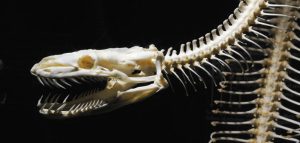
Snakes are a very diverse group of present-day reptiles, with nearly 3,600 known species. They are readily recognized by their long bodies and lack of limbs. The origin of snakes from lizard-like precursors with paired limbs has long been a controversial subject. This reflects the lack of fossils and conflicting results from phylogenetic assessments using molecules and anatomy, respectively. Thus a 2015 report announcing discovery of a 110-million-year-old skeleton of a snake-like reptile from the Cretaceous of Brazil generated worldwide interest.
Many researchers relate snakes to land-dwelling lizards such as monitor lizards and infer a burrowing or semi-burrowing ancestral mode of life to account for the evolution of the snake body plan. Some paleontologists noted a suite of anatomical features that links snakes to a group of Cretaceous-age marine lizards, the mosasaurs, and argue that snakes originally evolved in an aquatic setting.
The subject of the 2015 report is an articulated 20 cm long skeleton of a snake-like reptile from the Cretaceous of Brazil. Named Tetrapodophis (“four-footed snake”), this fossil has a long body with some 160 vertebrae in front of the tail but also four very small limbs. Such a combination of features had never been observed in any lizard or snake. Tetrapodophis purportedly showed that body elongation preceded loss of limbs in the evolution of snakes and thus gained international attention as a “transitional fossil.”
Recently a team of researchers led by Michael W. Caldwell (University of Alberta) has carefully re-examined the only known fossil of Tetrapodophis. They found that this reptile lacks many key features of snakes in its skull and vertebral column. Instead its long skull has large eye sockets and its teeth are not recurved, unlike those of snakes. Caldwell and his colleagues also observed that the limbs of the Brazilian specimen share traits with those of a number of water-dwelling reptiles. They concluded that Tetrapodophis probably used its long body for eel-like swimming or crawling.
Caldwell concludes: “This specimen challenges a number of long held ideas about the evolution of elongation and limb reduction in tetrapods—it displays anatomical features that seem to break all the rules. To make it more complicated, the skull is poorly preserved and the animal is extremely small, thus making it hard to pinpoint morphological features linking it to any one particular group of squamates [the group comprising lizards and snakes]. It is a perfect paleontological storm in every way.”
Note: The above post is reprinted from materials provided by Society of Vertebrate Paleontology.










